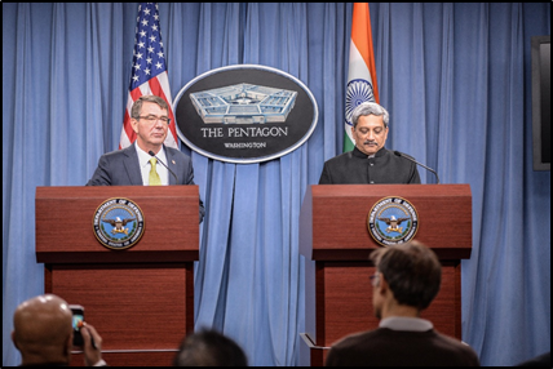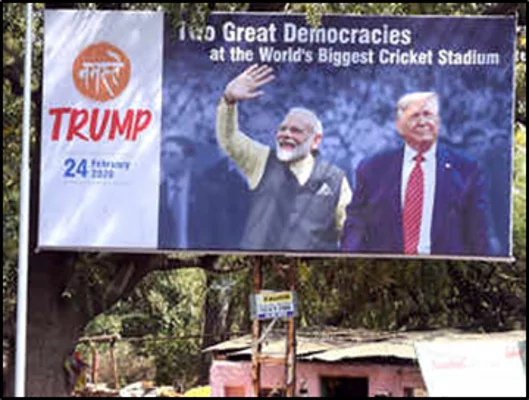
The India-U.S. Defense Relationship Grows Amid Rising Tensions with China
Publication: China Brief Volume: 20 Issue: 11
By:

Introduction
China’s rise and assertive behaviour in the Indo-Pacific Region—as demonstrated most recently by the June 15 clashes between Chinese and Indian troops in the Galwan Valley region (India Today, June 21)—has contributed to a strategic convergence between the United States and India. Although the Indian government’s official position on China has always been subdued or nuanced, concerns about the People’s Republic of China (PRC) have been growing for many years, under administrations of both of India’s primary political parties.
The thinking of the government can be gleaned from recent editions of the Annual Report of the Ministry of Defence. The report for 2009-2010, issued under the United Progressive Alliance (UPA) administration led by Prime Minister (PM) Dr. Manmohan Singh, observed that: “China is engaged in building its Comprehensive National Power encompassing economic and military development, which would enable her to play a dominant role in global affairs…India also remains conscious and alert about the implications of China’s military modernisation on the regional and national security situation” (Indian Ministry of Defence, 2010).
India’s Threat Perceptions and the Growth of India-U.S. Defense Cooperation
It was against this backdrop of growing threat perceptions in India, and a building Sino-Indian security dilemma, that defense cooperation between India and the United States has grown: it is China’s rise and assertive behaviour that has brought a closer relationship between the two vibrant democracies. Considering the democratic nature of the two political systems, the incubation of the strategic partnership between India and the United States has been relatively slow. However, the partnership has grown steadily, with bipartisan support among India’s rival political coalitions.
Strengthening Defense Ties Under PM Singh in 2012-2013
Then-U.S. Defence Secretary Ashton Carter was instrumental in giving a boost to the relationship with the launch of the Defence Trade Technology Initiative (DTTI) in 2012. Also in 2012, the Indian IT behemoth Tata Advanced System Limited (TASL) and Lockheed Martin established a joint venture to produce C-130J Super Hercules airframe components. TASL also has a joint venture with Sikorsky, established in 2011, to co-produce S-92 helicopter cabins. In June 2016, TASL and Boeing announced a Hyderabad-based joint venture to manufacture components for Apache helicopters, and to collaborate on integrated systems development opportunities in India (U.S. Embassy in India, December 8, 2016). It is no coincidence that negotiations surrounding the DTTI were intensified following an April 2013 border incursion by the PRC across the Line of Actual Control (LAC) in the Depsang sector (The Hindu, May 7, 2013), for this was yet another incident that increased India’s threat perceptions regarding its northern neighbour.
It was against this backdrop that Prime Minister Singh visited the United States in September 2013 to participate in the United Nations (U.N.) General Assembly, and held a side meeting with U.S. President Barack Obama. The Joint Statement issued by the two sides affirmed that “the partnership between the two democratic nations is stronger today than at any point in their 67-year history” (Indian PM Office, September 27, 2013). The two leaders reiterated their desire to further strengthen defense trade cooperation by endorsing a Joint Declaration on Defence Cooperation as a means of enhancing their partnership in military technology transfers, joint research, and co-development and co-production of certain types of military equipment. President Obama encouraged further participation by U.S. firms in partnering India’s efforts to enhance its defence capabilities (Indian Ministry of External Affairs, September 27, 2013).
Defense Ties Continue to Grow Under PM Modi Since 2014
The same engagement continued, but with added dimensions, after the Bharatiya Janata Party (BJP) administration of PM Narendra Modi came to power in May 2014. The Ministry of Defence report for 2014-15 reiterated concerns about China, and said that “India is also taking necessary measures to develop the requisite capability to counter any adverse impact on our own security” (Indian Ministry of Defence, 2015). A landmark development in the transformational defence and security cooperation between the two countries was the signing of the new Framework for the U.S.-India Defense Relationship in June 2015 (U.S. Department of Defense, 2015).
These arrangements were further strengthened when, after twelve years of protracted negotiations, the two countries signed the Logistics Exchange Memorandum of Agreement (LEMOA) in August 2016. LEMOA is a tweaked version of standard logistics cooperation agreements that the U.S. military has with dozens of counties. The agreement enables the naval ships and aircraft of both countries to dock in each other bases for refuelling and similar purposes. Indian and U.S. naval ships and aircraft have often used each other’s naval and air bases before; however, in the past this has been an ad hoc, complex action in which clearance had to be obtained for each individual case (The Hindu, August 30, 2016).
Continuing India-U.S. Defense Initiatives Since 2018
Against the backdrop of China’s belligerent behaviour, the renaming of the former U.S. Pacific Command as the “Indo-Pacific Command” (effective June 1, 2018) was yet another strategic gesture by the United States to co-opt India. In September 2018, the India-U.S. defence relationship received a major boost at the “2+2 Ministerial Dialogue” in New Delhi, where the “foundational” Communications Compatibility and Security Agreement (COMCASA) was signed between the two countries. COMCASA enables the Indian military to get a better picture of maritime activity in the Indian Ocean region, which is seeing increased Chinese military activity. In addition to this defense agreement, both sides agreed in a joint statement that they had discussed “advancing a free, open, and inclusive Indo-Pacific” and promoting “sustainable debt financing practices in infrastructure development”—widely viewed as a riposte to the PRC’s much touted Belt and Road Initiative (Indian Ministry of External Affairs, September 6, 2018).
The second round of the 2+2 Ministerial Dialogue between the two countries took place in Washington in December 2019. During the meeting, the two sides announced important progress under the DTTI— including the finalisation of a “statement of intent” to co-develop several projects, and the finalisation of standard operating procedures for setting forth implementation guidelines for projects under the DTTI. The two governments also signed the Industry-to-Industry Framework, which will establish a standing mechanism for dialogue between defence contractors in the United States and India. During the 2+2 meeting the two sides also welcomed the signing of the Industrial Security Annex (INA), which will facilitate the exchange of classified military information between the two sides (Indian Ministry of External Affairs, December 19, 2019).

India Looks to U.S. Arms Sales to Counter Chinese Military Capabilities
While a comprehensive diplomatic framework and legal edifice for defense cooperation is in progress, there has also been an exponential growth in defense trade between the two countries. India is gearing up to ramp up its capacity to meet threats to its security and territorial integrity. From 2008 through the end of 2016, U.S.-India defense trade increased from roughly $1 billion to over $15 billion dollars. This has included Indian procurement of: thirteen C-130 Hercules aircraft from Lockheed Martin; ten C-17 Globemaster and twelve P-8 Poseidon aircraft from Boeing; as well as twenty-two AH-64 Apache and fifteen CH-47 Chinook helicopters (U.S. Embassy in India, December 8, 2016).
The two countries also entered into a contract in December 2016 for the procurement of 145 U.S.-made M777 ultra-light howitzers. It was agreed that the first 25 howitzers would be sold off the shelf, while the remaining 120 would be assembled in India. The howitzers are likely to be deployed on the Line of Actual Control (LAC) along the contested India-China border, in the regions of Arunachal Pradesh and Ladakh (in Jammu and Kashmir). The LAC is not formally defined, which at times results in border transgressions by both sides. The M777s, which have been used by U.S. forces in Afghanistan and Iraq, will help India secure its borders with China along the LAC. Once ready for deployment, the howitzers will be transported by heavy-lift Chinook helicopters to forward area helipads, such as the Walong Advanced Landing Ground in Arunachal Pradesh (Economic Times, October 7, 2019).
The India-U.S. Defense Relationship—and Concerns About China—Grow Even Stronger in 2020
In his characteristic style, PM Modi hosted U.S. President Donald Trump in the city of Gujarat on February 24 this year and regaled him in a rousing road show from the airport to the Motera Stadium, touted to be the biggest cricket stadium in the world. During the visit, the India-U.S. relationship was declared to have been elevated to a “Global Comprehensive Strategic Partnership,” and PM Modi hailed it as one the defining partnerships of the 21st century. China was clearly the elephant in the room for this meeting, as revealed when President Trump contrasted India’s democracy with an unnamed “nation that seeks power through coercion, intimidation and aggression” (Economic Times, February 24).
During the February visit, President Trump announced a defense deal of more than $3 billion, under which India will buy additional U.S. military equipment, including MH-60R naval and AH64E Apache helicopters (Indian Ministry of External Affairs, February 25). This was followed by a subsequent announcement in April of the U.S. intent to sell to India a package of Harpoon air launched missiles and lightweight torpedoes worth $155 million. The sale of ten AGN Harpoon Block 11 air-launched missiles is to cost $92 million; while the MK54 All Up Round Lightweight Torpedoes and three MK 54 Exercise Torpedoes are estimated to cost $63 million (DSCA, April 13 and April 13).
The weapons sales announced earlier this year have a clear naval orientation—a growing concern for India, as China’s presence in the Indian Ocean is on the rise. The helicopter acquisitions will help strengthen the Indian Navy, which currently lacks helicopters of similar capability. The Harpoon missile system and MK54 torpedoes will be integrated into the P-81 maritime reconnaissance aircraft for anti-surface warfare missions in defence of critical sea lanes, while also enhancing the Indian Navy’s inter-operability with U.S. and other allied forces.
Conclusion
The coronavirus pandemic has resonated in the triangular relationship between India, China, and the United States, serving to further exacerbate Sino-Indian tensions that had already been building for a number of years. The growing estrangement between the two countries was demonstrated by yet another recent development: as the pandemic spread in the month of April, PM Modi, who is a consummate communicator, spoke to nearly all major world leaders—including President Trump—but not to PRC President Xi Jinping or PRC Premier Li Keqiang. This is a further sign of disquiet in the relationship between the two countries.
COVID-19 is certainly going to impact the geopolitics between countries in Asia, and to reshape and redefine the triangular relations between the United States, China, and India. In the case of China and India, both the pandemic and recent border clashes are increasing a geopolitical estrangement that was already underway. In this changing equation, the India-U.S. strategic partnership will likely be further strengthened as both countries watch with concern China’s increasingly belligerent posture in the Indo-Pacific Region.
Rup Narayan Das is a senior fellow of the Indian Council of Social Science Research at the Indian Institute of Public Administration. He has also served previously as a senior fellow at the Institute of Defence Studies and Analyses, New Delhi. The views expressed here are his own.




